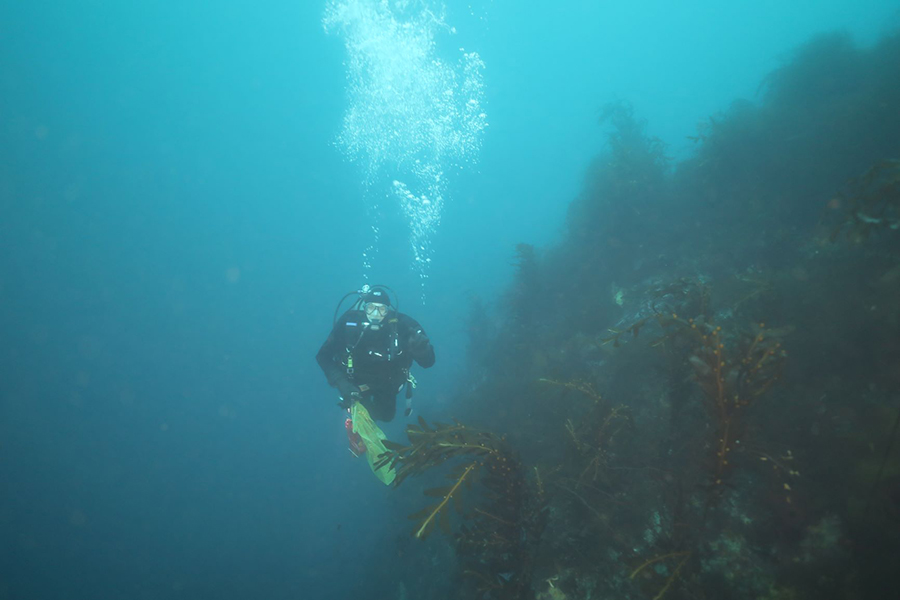Antarctic microbe produces potential cancer-fighting drugResearchers map the genetic machinery behind a natural anti-cancer compound from Antarctica for the first timePosted April 18, 2022
Scientists have identified the bacterium that produces palmerolide, a compound discovered in sea squirts living in Antarctic coastal waters that could potentially treat human melanoma, the most dangerous form of skin cancer. Researchers first isolated palmerolide in 2006 from a sea squirt living on the ocean floor near Palmer Station on the Antarctic Peninsula. They suspected the compound must be produced by symbiotic microbes living in the sea squirt's tissues but couldn't identify the specific microorganism that was producing it. 
Photo Credit: Bill Baker.
The sea squirt that produces palmerolide, an anti-cancer compound that targets melanoma cells.
By sequencing DNA from all the microbes inhabiting that sea squirt species, scientists have now identified the organism that makes palmerolide. It's a previously unstudied bacterial species called Candidatus Synoicihabitans palmerolidicus that has yet to be cultured in a lab. The researchers also mapped the specific genes within that microbe's DNA carrying the instructions for making palmerolide. It's the first time scientists have identified the genes responsible for making a known natural product found in Antarctica. “It's a real first for Antarctic science and that part, I think, is quite important,” said Alison Murray, a microbial ecologist at Desert Research Institute in Reno, Nevada and lead author of a new study detailing the findings. The discovery is a huge leap forward in developing a naturally-derived treatment that specifically targets melanoma, according to the study authors. The next step is to see if the microbe can be cultured in a lab or if palmerolide could be made using bioengineering. “Now that we understand the underlying genetic machinery, it opens the door for us to find a biotechnological solution to produce this compound,” Murray said in a statement. Microbial drug factoriesOcean-dwelling plants, animals and microbes make many natural products used in human medicine, such as cancer treatments, antibiotics, and even cholesterol-lowering compounds. Often these compounds serve a specific purpose to the organism producing them: they may provide a chemical defense against predators, produce light, or protect the organism from ultraviolet rays. But many of these compounds have been isolated from organisms living in temperate or tropical waters and few have been discovered in Antarctica. In 2006, researchers discovered an Antarctic sea squirt that produces palmerolide (so named because it was found near Palmer Station). Sea squirts are potato-shaped invertebrate animals that inhabit oceans all over the world. Most adult sea squirts are permanently attached to rocks or other hard surfaces on the seafloor. Palmerolide is related to a class of molecules called macrolides, many of which are commonly used antibiotics. When researchers discovered palmerolide, they found it had the potential to kill melanoma cells while leaving most other types of cells undisturbed. That's because palmerolide inhibits an enzyme melanoma cells use much more than other cells do. Most cancer treatments kill healthy cells along with the cancerous ones, so palmerolide could provide a much-needed therapeutic option for melanoma. “That's exciting, because there aren't very many specific drugs that target just melanoma,” Murray said. Solving the puzzleResearchers knew palmerolide was associated with this sea squirt and its symbionts, but they didn't know exactly where it came from. Two years ago, Murray and her colleagues used tissue samples collected from more than 60 sea squirts dwelling near Palmer Station to identify 21 types of bacteria that reside in the animal's tissues. In the new study, they sequenced the DNA collected from those samples to figure out which of those 21 bacterial species were responsible for producing palmerolide. With the help of some clever reasoning, the researchers identified the bacterium that makes palmerolide and mapped the genes that encode for its production. They also found palmerolide is not made by any other known organism besides the microbes living in this particular sea squirt. “Palmerolide and the genes that create it really are unique,” Murray said. “To me it's been a very fun puzzle to solve. We were able to use the scientific method in a number of ways here to really solve this problem that's now fifteen years old.” The researchers are not sure where else around Antarctica this sea squirt and its drug-producing bacteria might reside. But their next step is to collect more samples and attempt to grow the bacteria in the lab or find a way of producing palmerolide in a surrogate host. Many types of symbiotic bacteria are difficult to culture in the lab as it's challenging to reproduce their preferred living conditions, but Murray is confident they will be able to do so. “There's nothing that I've seen yet in the genome that makes me think that we cannot,” she said. “I'm really pretty excited for the future of this project.” This research is supported by the National Science Foundation, which manages the U.S. Antarctic Program. NSF-funded research in this story: Bill Baker, University of South Florida, awards 0442857, 0838776, and 1341339. |
"News about the USAP, the Ice, and the People"



For USAP Participants |
For The Public |
For Researchers and EducatorsContact UsU.S. National Science FoundationOffice of Polar Programs Geosciences Directorate 2415 Eisenhower Avenue, Suite W7100 Alexandria, VA 22314 Sign up for the NSF Office of Polar Programs newsletter and events. Feedback Form |



